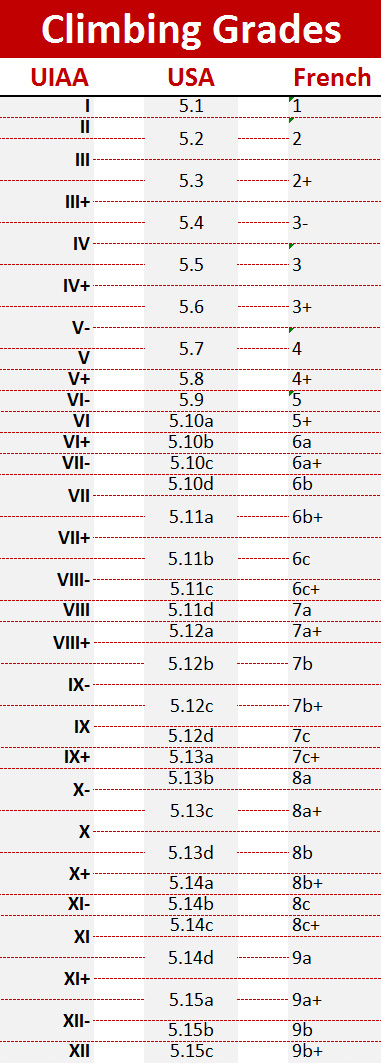Climbing Grades | EU – FR – US
Just to help you navigate through the grade jungle here a quick overview of the current grading scales, there exist several others (Norwegian, Australian, UK, etc.) but these are by far the most popular ones in the Americas and Europe-Mainland.
Important:
Climbing grades are not really objective numbers. The grades listed on the right include several dimensions like route style (slab, wall, overhang, etc.), size of the crimps, quality of the footholds, distance and complexity of the movements, etc.
However what all the grading scales on the right do not include is the mental and security component of the climb, e.g. is the protection sufficient or do you die before reaching the first or second bolt, or how stable are the moves in relation to the protection given. Is the route protected with anchors or bolts or at least protectable with your own gear. The only climbing scales that do include the above mentioned features are the British, the Alpine and in part the Australian system. Both systems are not used outside of their local areas. That is in part due to the peculiar style of climbing in the UK which per default includes precarious routes with limited to no protection possibilities.
You sometimes wish that the scales on the right would also reflect a mental or protection component, as this does not mean in routes with those scales you do not encounter massive mental challenges or issues with the protection. However in cases where the scales on the right are used you need to rely on good guidebooks with comments about the quality of the rock, the protection or potential run-outs. In part that makes the UK system kind of fairer and more predictable, but far from less dangerous. So always scout the routes (e.g. the bolts, their distance and quality) and the area (e.g. for fallen rocks). Particularly in areas exposed to extrem weather conditions watch out for rusty anchors or chains. In all circumstances check the distance to the first bolt and judge the toughness of the route until that point as well as the area below the route, also check the 2nd and 3rd bolt, particularly in areas such as Palatina and the Altmuehltal in Germany the first bolt can be deceitful and even a fall below the 2nd or 3rd bolt can mean certain injury, so make sure you can climb the grade in your sleep and fully control it.
In general climb responsibly and base the risk on your capabilities!

